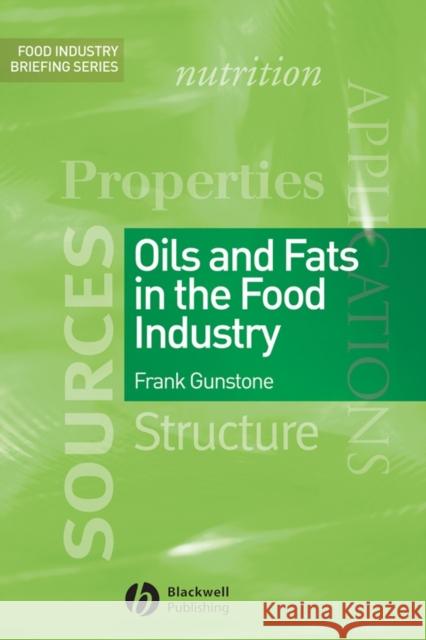Oils and Fats in the Food Industry » książka



Oils and Fats in the Food Industry
ISBN-13: 9781405171212 / Angielski / Miękka / 2008 / 160 str.
Oils and Fats in the Food Industry
ISBN-13: 9781405171212 / Angielski / Miękka / 2008 / 160 str.
(netto: 301,08 VAT: 5%)
Najniższa cena z 30 dni: 314,83
ok. 30 dni roboczych
Bez gwarancji dostawy przed świętami
Darmowa dostawa!
A concise and easy-to-use reference for those who need to gain an outline working knowledge of oils and fats in the food industry. It examines the current main concerns of the food industry regarding oils and fats use, including diet and health, public perception, and environmental aspects.
"This volume provides a concise and easy–to–use reference on the nature of oils and fats for those working in the food industry and for those in the media seeking to advise the public .The references, websites and index are well catered for." ( Food and Beverage Reporter, April 2009)
"An easy–to–use and concise reference for food engineers as well as media experts." (The Chemical Engineer, November 2008)
Chapter 1. The Chemical Nature of Lipids.
1.1 Fatty acids.
1.2 Triacylglycerols.
1.3 Ester waxes.
1.4 Phospholipids.
1.5 Sterols and sterol esters.
1.6 Tocols.
1.7 Hydrocarbons.
Chapter 2. The Major Sources of Oils and Fats.
2.1 Introduction.
2.2 Animal fats (butter, lard, tallow, chicken fat, and fish oils).
2.3 Cocoa butter and cocoa butter alternatives.
2.4 Lauric oils (coconut, palm kernel).
2.5 Olive oil.
2.6 Palm oil.
2.7 Rapeseed (canola) oil.
2.8 Soybean oil.
2.9 Sunfl ower seed oil.
2.10 Other vegetable oils.
2.11 Single cell oils.
Chapter 3. Extraction, Refining, and Modification Processes.
3.1 Extraction.
3.2 Refining.
3.3 Modification processes.
3.4 Blending.
3.5 Fractionation including winterisation and dewaxing.
3.6 Hydrogenation.
3.7 Interesterification using a chemical catalyst.
3.8 Interesterification using an enzymatic catalyst.
3.9 Domestication of wild crops.
3.10 Oilseeds modified by conventional seed breeding or by genetic engineering.
3.11 Animal fats modified through nutritional changes.
Chapter 4. Analytical Parameters.
4.1 Introduction.
4.2 Oil content.
4.3 Unsaturation iodine value.
4.4 Saponification free acids, sap value.
4.5 Melting behaviour, solid fat content, low temperature properties.
4.6 Oxidation peroxide value, anisidine value, stability, shelf life, stability trials, taste panels.
4.7 Gas chromatography.
4.8 Near–infrared and Fourier transform infrared spectroscopy.
4.9 1H NMR spectroscopy.
4.10 13C NMR and 31P NMR spectroscopy.
4.11 Mass spectrometry.
Chapter 5. Physical Properties.
5.1 Polymorphism, crystal structure, and melting point.
5.2 Alkanoic and alkenoic acids.
5.3 Glycerol esters.
5.4 Ultraviolet spectroscopy.
5.5 IR and Raman spectroscopy.
5.6 Nuclear magnetic resonance spectroscopy.
5.7 Mass spectrometry.
5.8 Density.
5.9 Viscosity.
5.10 Refractive index.
5.11 Solubility of gases in oils.
5.12 Other physical properties.
Chapter 6. Chemical Properties.
6.1 Hydrogenation.
6.2 Atmospheric oxidation.
6.3 Thermal changes.
6.4 Reactions of the carboxyl/ester function.
Chapter 7. Nutritional Properties.
7.1 Introduction.
7.2 EFA and fatty acid metabolism.
7.3 De novo synthesis of saturated acids.
7.4 Desaturation and elongation in plant systems.
7.5 Desaturation and elongation in animal systems.
7.6 Antioxidants.
7.7 Cholesterol and phytosterols.
7.8 Conjugated linoleic acid.
7.9 Diacyglycerols.
7.10 Recommended intake of fats and of fatty acids.
7.11 Role of fats in health and disease.
7.12 Obesity.
7.13 Coronary heart disease.
7.14 Diabetes.
7.15 Inflammatory diseases.
7.16 Psychiatric disorders.
7.17 Cancer.
Chapter 8. Major Edible Uses of Oils and Fats.
8.1 Introduction.
8.2 Spreads butter and ghee.
8.3 Spreads margarine, vanaspati, and flavoured spreads.
8.4 Baking fats and shortenings.
8.5 Frying oils and fats.
8.6 Salad oils, mayonnaise and salad cream, French dressing.
8.7 Chocolate and confectionery fats.
8.8 Ice cream.
8.9 Incorporation of vegetable fats into dairy products.
8.10 Edible coatings.
8.11 Emulsifying agents.
8.12 Functional foods.
8.13 Appetite suppressants.
References and Further Reading.
Useful Websites.
Index.
Frank Gunstone is Professor Emeritus, University of St Andrews and Honorary Research Professor, Scottish Crop Research Institute, Dundee, UK. He has been editor of Lipid Technology for ten years.
Oils and fats are almost ubiquitous in food processing whether naturally occurring in foods or added as ingredients for functional benefits and, despite the impression given by several sources to the contrary, they remain an essential part of the human diet. However, it is increasingly apparent that both the quantity and the quality of the fat consumed are vital to achieving a balanced diet. Health concerns regarding high–fat diets continue to have a high profile, and still represent a pressing issue for food manufacturers.
This volume provides a concise and easy–to–use reference on the nature of oils and fats for those working in the food industry and for those in the media seeking to advise the public on consumption. Written in a style that makes the concepts and information contained easily accessible, and using a minimum of chemical structures, the nature and composition of the constituents of oils and fats are explained. The major sources of food lipids (vegetable and animal fats) are outlined, along with their physical characteristics. The book also focuses on the current main concerns of the food industry regarding oils and fats use, including: the nutritional properties of fats and oils and their various components; links between chemical structure and physiological properties; and the role of lipids in some of the more important disease conditions such as obesity, diabetes, coronary heart disease and cancer. The final chapter is devoted to a description of the most common food uses of oils and fats.
The book will be of interest to food industry professionals, students or others who require a working knowledge of oils and fats in the food industry.
1997-2025 DolnySlask.com Agencja Internetowa
KrainaKsiazek.PL - Księgarnia Internetowa









